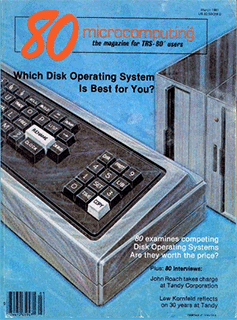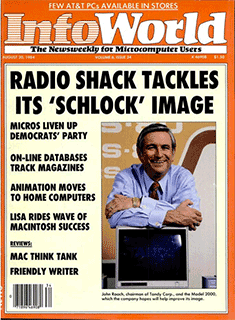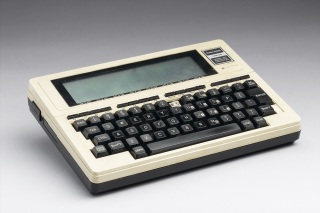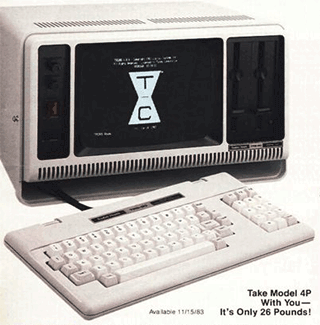Radio Shack's TRS-80 Model I microcomputer, complete with Expansion Interface, floppy-disk drive and printer
Just writing about all this is giving me a Proustian jolt of pleasure. I spent thousands of hours sitting in front of TRS-80s, cranking out programs in BASIC. I knew the machine inside and out, in a way that’s impossible with modern computers. I didn’t even mind dealing with its quirks, such as “keybounce,” a devilish defect with early models which lled to their keyyboards repeatiing characters randomlyy.

Wayne Green
Let’s recap. The TRS-80 was useful. It was fun. It was popular. It played at least as great a role as any other single machine in consumerizing what had originally been a product category for the propellerhead set. But somehow, it never got anywhere near the respect it deserved. Back in the day, computer fans who weren’t TRS-80 users tended to dismiss it as ugly and insignificant.
In fact, TRS-80 haters had a favorite put-down, which they used at every possible opportunity: They called it the Trash-80.
There are those who claim that this was a nickname fondly applied by TRS-80 fans themselves; maybe so, but I’m positive it originated as a slur. I certainly remember being wounded by it at the time when it was used by Apple II owners–those pompous, style-obsessed twits.
Even today, “Trash-80” strikes me as a mindless jibe that reveals more about the people who used it than it does about the TRS-80. The TRS-80 wasn’t perfect; even so, it was one of the best PCs of its time. Suggesting that it was a piece of junk was both mean and inaccurate.
Why was the TRS-80 the Rodney Dangerfield of early computers? In part, it was because it was a decidedly proletarian device which didn’t look important. Its graphics were ugly. So was its plasticky gray case; the TRS-80 got its design aesthetic, such as it was, because Radio Shack modeled the computer itself on the monitor, which was actually a repurposed RCA TV set. By contrast, the Apple II did Atari-like color graphics and came in a curvy beige case with the feel of a piece of high-end consumer electronics.

Google Books
Then there was Radio Shack itself. Even if you’re fond of the place — as I was, and am — it’s difficult to argue that it was good for the reputation of the TRS-80. Its essential lack of dignity transferred itself to the computers the company made.
At a Radio Shack store, the TRS-80 wasn’t surrounded by other computers; it sat alongside odd electronic toys, Radio Shack-branded hi-fi equipment, diodes and resistors and vacuum tubes, Flavoradios, and lots and lots of batteries and audio cassettes. Most of the people behind the counters, in my experience, knew very little about the TRS-80. They did, however, want to collect your name and address every time you made a purchase in order to carpet-bomb your mailbox with ads, a practice the company terminated only in this century.
For a time, there were also Radio Shack Computer Centers which tried for a more corporate feel, although the mere fact that they had the words “Radio Shack” in their name made them feel like, well, Radio Shacks. Radio Shack is still struggling with its moniker today: It changed it to RadioShack in 2000, and has recently taken to calling itself “The Shack.”
If Radio Shack was bothered by its image problem in the TRS-80 era, at least it got to cry all the way to the bank. Even after the Apple II, Commodore 64 and other competitors became blockbusters, the company continued to sell plenty of computers. It also aggressively broadened the TRS-80 line, starting with 1979’s Model II, a more expensive, business-oriented model.

Getty Images
1980’s TRS-80 Model III — essentially the Model I in an all-in-one-case — was a best-selling workhorse. 1983’s TRS-80 Model 100, the first successful notebook computer, might have been a more important machine than the original TRS-80. Radio Shack even sold high-end computers in configurations that cost as much as $22,000, or at least attempted to do so.
But as the computer world began to change at a dizzying pace, the TRS-80 line evolved only in baby steps. Even I wasn’t impressed by 1980’s cheesy and underpowered TRS-80 Color Computer; I was frankly dismayed when my high-school buddy Charles chose to buy one. (Then again, the Color Computer has its partisans even now. I suspect I’ll hear from some of them — maybe even Charles.)

RadioShackCatalogs.com
In 1984, the year Apple introduced the landmark it called the Macintosh, Radio Shack was still noodling around with variations on the Model I such as the Model 4P, a 26-pound “portable.” That was also the year it released the Tandy 1000, a computer Wikipedia correctly calls a “more-or-less IBM PC compatible” system.
For a while, Radio Shack seemed to flourish as a maker of PC clones, but by the mid-1990s, it decided to exit the PC business. It then sold other companies’ models, such as Compaqs. But its days as a major purveyor of PCs are so far behind it that I wasn’t even sure whether today’s Radio Shack sells computers at all until I checked. (It turns out that it does; it’s also one of the handful of retailers authorized to sell the iPad.)
The last TRS-80 on the market was the Model 102, a slightly-improved variant of the Model 100. It expired in the early 1990s, and at the end, Radio Shack simply called it the “Tandy 102.” There’s a modern trend of releasing new computers under famous old names, but I hope that the Shack leaves well enough alone: No new TRS-80 could be anywhere near as important in 2012 as the original one was in 1977.
That original model and its relatives are lovingly documented on the web. Ira Goldklang, proprietor of TRS-80 Revived, is a one-man National TRS-80 Museum. Matthew Reed blogs engagingly about the machines at TRS-80.org. If you ever looked forward to the arrival of new Radio Shack catalogs as much as I did, visiting RadioShackCatalogs.com is like taking a time machine back to your own past. And truly serious TRS-80 admirers can even run old TRS-80 programs on new computers via emulation.
Also worth a read: David Welsh and Theresa Welsh’s Priming the Pump, a history of the TRS-80 which is now available in a Kindle edition.
So ha ha, TRS-80 haters: The machine you loved to dismiss has stood the test of time. I knew back in high school that the Model I didn’t get enough credit. But I didn’t anticipate how much it would continue to matter to citizens of the 21st century, myself included.
Trash-80? Don’t be silly — it’s a treasure.
MORE: Clamshell! The Story of the Greatest Computing Form Factor of All Time


